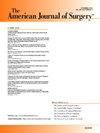From past to present: A comparison of interpersonal firearm violence between historically graded neighborhoods of Kansas City
IF 2.7
3区 医学
Q1 SURGERY
引用次数: 0
Abstract
Background
Interpersonal firearm violence (IFV) has been connected to the structural racism of redlining. We explored the relationship between historic redlining and IFV with population-level factors.
Methods
A cross-sectional study of IFV within historically graded neighborhoods was performed, and incidence rate ratios (IRRs) between these neighborhoods and the rate of IFV were modeled with a Poisson regression model.
Results
Comparing redlined to non-redlined neighborhoods, the IRRs adjusted for income was 14.9 (p < 0.0001), adjusted for poverty was 14.4 (p < 0.0001), adjusted for uninsured was 15.6 (p < 0.0001), and adjusted for IFV-related mortality was 26.05 (p < 0.0001). After county adjustment, every one unit increase in logarithm of income decreases the IFV rate by 64.7 % (p < 0.0001), whereas every one percent increase of poverty and uninsured, increases the IFV rates by 4.1 % (p < 0.0001) and 3.05 % (p < 0.0002), respectively.
Conclusion
Historically redlined communities have higher rates of IFV in Kansas City, Kansas.

从过去到现在:堪萨斯城历史上分级街区之间人际枪支暴力的比较
本文章由计算机程序翻译,如有差异,请以英文原文为准。
求助全文
约1分钟内获得全文
求助全文
来源期刊
CiteScore
5.00
自引率
6.70%
发文量
570
审稿时长
56 days
期刊介绍:
The American Journal of Surgery® is a peer-reviewed journal designed for the general surgeon who performs abdominal, cancer, vascular, head and neck, breast, colorectal, and other forms of surgery. AJS is the official journal of 7 major surgical societies* and publishes their official papers as well as independently submitted clinical studies, editorials, reviews, brief reports, correspondence and book reviews.

 求助内容:
求助内容: 应助结果提醒方式:
应助结果提醒方式:


